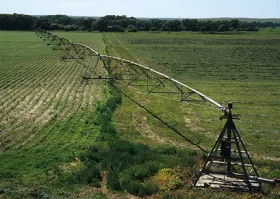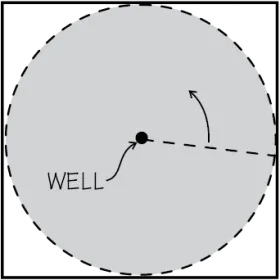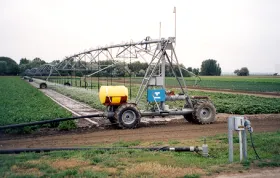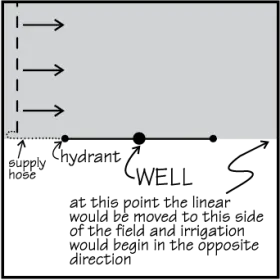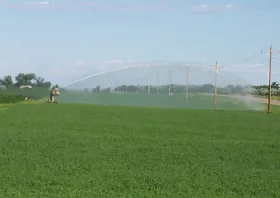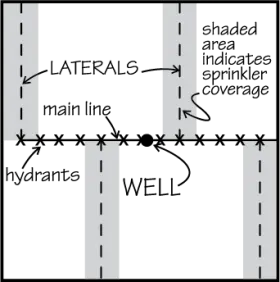The sprinkler system capacity is the flow rate needed to irrigate an area adequately and is expressed in gallons per minute per acre (gpm/acre). The required irrigation system capacity is dependent on the:
- Peak crop water requirements during the growing season
- Maximum effective crop root depth
- Texture and infiltration rate of the soil
- Available water-holding capacity of the soil
- Pumping capacity of the well or wells
- Department of Water Resources-permitted pumping rate
Table 1 shows the system capacity needed for the most commonly irrigated crops in North Dakota and common irrigated soil textures. To use this table, you must determine the dominant soil texture in the field and what type of crops will be grown (the crop rotation), then determine the appropriate system capacity.
For example, if you plan a three-year rotation of potatoes, corn and soybeans on loamy sand, you can determine from Table 1 that potatoes require 7 gpm/acre, corn 5.9 gpm/acre and soybeans 6.4 gpm/acre. Select a design system capacity for the potatoes at 7 gpm/acre.
If you install a center pivot system covering 130 acres, ideally you would need about 910 gpm (7 x 130). The most common irrigated soils are loamy sands or sandy loams that require a flow rate of about 6 gpm/acre for full-season irrigation. A lesser flow rate can be used, but more intensive water management will be required, especially during years with less than average growing season precipitation.
A sprinkler system must be designed to apply water so no runoff or erosion occurs. The application rate of the sprinkler system must be matched to the intake rate of the most restrictive soil in the field. If the application rate exceeds the soil intake rate, the water will run off the field or relocate within the field, resulting in over- and underwatered areas. Conservation tillage and residue management can help control runoff.
Table 1. System capacity in gallons per minute per acre (gpm/acre) for different soil textures needed to supply
sufficient water for each crop in nine out of 10 years. An application efficiency of 80 percent and a 50 percent depletion of available soil water were used for the calculations.
|
Crop
|
Root Zone Depth (ft)
|
Coarse Sand and Gravel
|
Sand
|
Loamy Sand
|
Sandy Loam
|
Fine Sandy Loam
|
Loam and
Silt Loam
|
|
Potatoes*
|
2.0
|
8.2
|
7.5
|
7.0
|
6.4
|
6.1
|
5.7
|
|
Dry beans
|
2.0
|
7.9
|
7.1
|
6.4
|
6.1
|
5.7
|
5.4
|
|
Soybeans
|
2.0
|
7.9
|
7.1
|
6.4
|
6.1
|
5.7
|
5.4
|
|
Corn
|
3.0
|
7.3
|
6.6
|
5.9
|
5.5
|
5.3
|
4.9
|
|
Sugar beets
|
3.0
|
7.3
|
6.6
|
5.9
|
5.5
|
5.3
|
4.9
|
|
Small grains
|
3.0
|
7.3
|
6.6
|
5.9
|
5.5
|
5.3
|
4.9
|
|
Alfalfa
|
4.0
|
6.8
|
5.9
|
5.6
|
5.1
|
5.0
|
4.5
|
*Adjusted for 40 percent depletion of available water.
